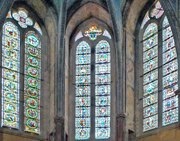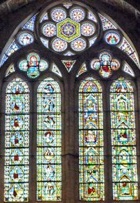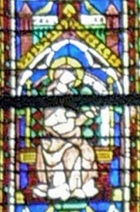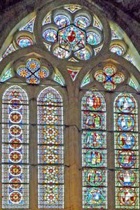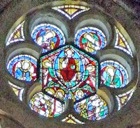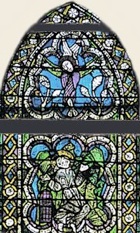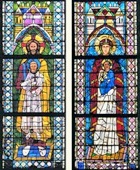The programme of inserting stained glass into the windows of the upper church began in the apse (illustrated above). This work was probably carried out in response to the bull "Decet et expedit" (1253), in which case it would have been commissioned by Cardinal Rinaldo dei Conti di Segni, the Cardinal Protector of the Order. He became Pope Alexander IV in the following year. There was no history of stained glass in Italy at this time, and scholars attribute the work to craftsmen from Northern Europe.
There seems then to have been a hiatus in the decoration of the upper church until ca. 1275, when the programme resumed with the glazing of the left transept. This work was almost certainly done by craftsmen from France. The stained glass in the other windows of the upper church was completed soon thereafter. Most of this later work seems to have been done by Italians who had learnt the art from the French. (The reasoning for the chronology of the work of glazing the upper church and its historical context are discussed in the page on San Francesco in the period 1253-1300).
The windows have been particularly susceptible to earthquake and other damage over the centuries, but they have fortunately suffered less than might be expected from “restoration”. They were subject to a major restoration in 1948-51, following the Second World War.
Apse (ca. 1260)
There are three double lancets in the apse, the windows of which were almost certainly executed by craftsmen from Northern Europe. The scenes in each lancet depict the life of Christ (read from the bottom to the top), with corresponding scenes from the Old Testament opposite.
An inscription below the two lancets on the left records the restoration of this glass in Perugia in 1918-28 by Rosa and Cecilia Caselli. Many of the original scenes had to be replaced as part of this work.
Left transept (ca. 1275)
The designs for this four-lancet window is attributed to artists from France.
-
✴The two lancets on the left a depict scenes from Genesis, with Christ the Redeemer and SS Francis and Antony of Padua in the quadrilobe above.
-
✴The two lancets to the right depict female saints (including the newly-canonised St Clare (the third figure from the bottom, on the left), with the Madonna and Child and two prophets in the quadrilobe above
Right transept (ca. 1275)
-
✴The two lancets on the left contain geometric designs.
-
✴The two lancets to the right contain scenes read from the top to the bottom that depict:
-
•visions of angels taken from the Old Testament (on the left); and
-
•visions of the resurrected Christ (on the right).
-
✴The central rose window above depicts the Ascension of Christ, with:
-
•angels in the tondi above and to the sides; and
-
•six kneeling disciples in each of the tondi below.
Nave (ca. 1275)
The nave contains four double lancet windows on each side:
-
✴The designs of those in the 3rd and 4th bays on the right are attributed to artists who seem to have come from France.
-
✴The designs of the others are attributed to the Maestro di San Francesco.
With the exception of the first bay on each side (see below), the lancet windows contain standing Apostles, with scenes from their lives above. These scenes are taken from the Golden Legend (ca. 1265) by Jacobus de Voragine.
-
✴The scenes from the lives of SS James and Andrew in the fourth bay on the right have been lost and replaced by modern glass.
-
✴The original glass of the second bay on the left has been lost. These lancets were almost certainly devoted to SS Peter and Paul.
-
✴Many of the heads of the figures have been replaced by modern copies.
The windows of the first bay on each side are devoted to the “new Apostles”:
-
✴The lancet windows in the first bay on the right contain standing figures of SS Francis and Antony of Padua, with scenes from their lives above. The scenes from the life of St Francis depict, from the bottom:
-
•St Francis before the Crucifix at San Damiano (the earliest surviving image of this scene);
-
•St Francis’ posthumous cure of a crippled man (out of chronological sequence);
-
•the dream of Pope Innocent III, with St Francis supporting the Church;
-
•St Francis preaching to the birds; and
-
•the stigmatisation of St Francis (illustrated here).
-
✴The lancet windows in the first bay on the left contain:
-
•Christ holding St Francis, with angels above (on the left); and
-
•the Madonna and Child, with angels above (on the left).
When the Blessed Angela of Foligno visited San Francesco in 1291, this image of St Francis in the arms of Christ provoked a violent religious experience that led to her eviction from the church. It seems likely that all the windows of the upper church were complete by that time.
Read more:
R. Brooke, “Image of St Francis: Responses to Sainthood in the 13th Century”, (2006) Cambridge (Ch 9)
Return to the Upper Church.
Return to the main page on San Francesco.
Return to Walk III.
Return to the home page on Assisi.



